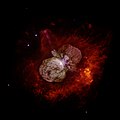चित्र:Eta Carinae.jpg
Appearance

या झलकेचा आकार: ६०० × ५९९ पिक्सेल पिक्सेल. इतर resolutions: २४० × २४० पिक्सेल | ४८० × ४८० पिक्सेल | ७६९ × ७६८ पिक्सेल | १,०२५ × १,०२४ पिक्सेल | २,०१५ × २,०१३ पिक्सेल.
मूळ संचिका (२,०१५ × २,०१३ पिक्सेल, संचिकेचा आकार: १६३ कि.बा., MIME प्रकार: image/jpeg)
संचिकेचा इतिहास
संचिकेची त्यावेळची आवृत्ती बघण्यासाठी त्या दिनांक/वेळेवर टिचकी द्या.
| दिनांक/वेळ | छोटे चित्र | आकार | सदस्य | प्रतिक्रीया | |
|---|---|---|---|---|---|
| सद्य | १५:११, १८ डिसेंबर २०१७ |  | २,०१५ × २,०१३ (१६३ कि.बा.) | The NMI User | Reverted to version as of 14:14, 1 May 2008 (UTC) |
| २०:१५, १३ मार्च २०१७ |  | ३,००० × २,९९८ (१.१८ मे.बा.) | Leogorgon | larger file size | |
| १९:४४, १ मे २००८ |  | २,०१५ × २,०१३ (१६३ कि.बा.) | Vol de nuit | {{Information |Description=(NASA News Release) A huge, billowing pair of gas and dust clouds are captured in this stunning NASA Hubble Space Telescope image of the supermassive star Eta Carinae. Using a combination of image processing techniques (ditheri |
दुवे
या चित्राशी जोडलेली पृष्ठे नाहीत.
जागतिक संचिका उपयोग
संचिकाचे इतर विकिपीडियावरील वापरः
- da.wikipedia.org वरील उपयोग
- en.wikipedia.org वरील उपयोग
- Star
- Eta Carinae
- Wikipedia:Selected anniversaries/March 11
- Wikipedia:Today's featured article/March 2017
- Wikipedia:WikiProject Wikipack Africa Content/Wikipedia:Showcase
- Wikipedia:WikiProject WikiFundi Content/Eta Carinae
- Wikipedia:Today's featured article/requests/Eta Carinae
- Wikipedia:Today's featured article/March 12, 2017
- Wikipedia:Main Page history/2017 March 12
- Wikipedia:WikiProject WikiFundi Content/Wikipedia:Showcase
- Wikipedia:Main Page history/2022 March 11
- Wikipedia:Main Page history/2022 March 11b
- Wikipedia:Main Page history/2023 March 11
- Wikipedia:Main Page history/2023 March 11b
- User:2003 LN6/sandbox/Eta Carinae variable
- List of luminous blue variable stars
- en.wikiversity.org वरील उपयोग
- User:Marshallsumter/Radiation astronomy2/Visuals
- User:Marshallsumter/Radiation astronomy2/Violets
- Stars/Astronomy
- User:Marshallsumter/Radiation astronomy2/Violets/Quiz
- Stars/Sun/Astronomy/Quiz
- User:Marshallsumter/Radiation astronomy/Courses/Principles/Hourly 2
- User:Marshallsumter/Radiation astronomy/Courses/Principles/Final quiz
- Draft:Original research/Io/Quiz
- Titan/Quiz
- Stars/Solar systems/Quiz
- Moon/Quiz
- Earth/Quiz
- User:Marshallsumter/Radiation astronomy/Colors/Quiz
- Volcanoes/Io/Quiz
- Stars/Violets
- User:Marshallsumter/Radiation astronomy2/Stars
- Stars/Violets/Quiz
- es.wikipedia.org वरील उपयोग
- fr.wikipedia.org वरील उपयोग
- hi.wikipedia.org वरील उपयोग
- it.wikibooks.org वरील उपयोग
- la.wikipedia.org वरील उपयोग
- mk.wikipedia.org वरील उपयोग
- ms.wikipedia.org वरील उपयोग
- my.wikipedia.org वरील उपयोग
- oc.wikipedia.org वरील उपयोग
- ru.wikipedia.org वरील उपयोग
- sk.wikipedia.org वरील उपयोग
- sr.wikipedia.org वरील उपयोग
- th.wikipedia.org वरील उपयोग
या संचिकेचे अधिक वैश्विक उपयोग पहा

